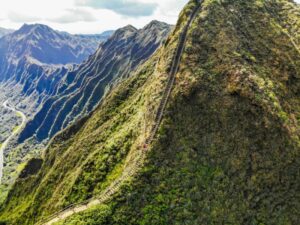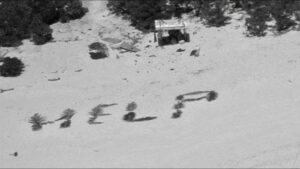Australia is the sixth-largest country in the world by area and features every type of landscape from dense rainforest to bone-dry desert. Temperatures can soar above 40˚C and plummet to 0˚C within hours. Its size and ruggedness invite adventure, and over the years, there have been some true Australian classics. Here is our pick of the country’s hardest modern expeditions.
Jon Muir: Trekked alone and unsupported across Australia

Wild man: Jon Muir trekked alone across Australia in 2001. Photo: Australia Museum
Australia’s Outback is huge, largely unpeopled, and extremely harsh. It crosses three mountain ranges (MacDonnell, Musgrave, and Petermann) and four deserts (Gibson, Great Sandy, Great Victoria, and Tanami). During summer, the flats can bake at 45˚C. Water is scarce and hard to find.
In 2001, Jon Muir walked 2,500km alone across this formidable land. Starting in Port Augusta, he finished 128 days later in Burketown, without a GPS or resupplies. This is what makes the trip so remarkable: Over those months, he managed to scrounge most of his own food and water. It included scavenging dead cows found along the way, but also a lot of termites. Once, he dined on a feral cat.
Muir pulled his supplies in a cart. He had 55 maps, a compass, rice, muesli, and a gun. Mostly, he survived on rainwater. His only companion was his Jack Russell, Seraphine.
“It was a self-imposed isolation that came in the form of a quest to walk across Australia, hunting and gathering along the way, using only my own energy to get me there”, Muir said later. “But it wasn’t loneliness, rather an incredible sense of aloneness.”
For four months, Muir went without a shower. Sometimes the puddles he drank from were polluted with dead animals. When he finished his expedition, he’d lost a third of his body weight.
Paul Caffyn: Circumnavigated Australia by kayak

Paul Caffyn. Photo: Australian Geographic
Paul Caffyn’s circumnavigation of Australia might be the most incredible kayak expedition of all time. In 1982, he spent 360 days paddling 15,000km.
Caffyn had already kayaked around New Zealand and Great Britain. Paddling around Australia started as a joke but evolved into a bull-headed expedition to take on the seemingly impossible.
Australia is one of the most formidable sea kayaking circumnavigations in the world. Caffyn paddled alone, through the surf and big waves. He survived a cyclone and always had to stay alert for crocodiles. But the Zuytdorp Cliffs were by far the biggest challenge.
Considered impossible to paddle because it required covering 160km without landing, the Zuytdorp Cliffs required skill, determination, and planning.
He used caffeine pills to stay awake. He slit a hole in his wetsuit to pee and took anti-diarrhea tablets to subdue his bowels. Then Caffyn paddled the entire stretch of limestone in 36 nonstop hours.
He was the first person to kayak the Zuytdorp Cliffs, and eventually became the first person to circumnavigate Australia by kayak.
In 2009, Freya Hoffmeister became the first woman to kayak around Australia. It took her 322 days.
Andrew McAuley: Attempted to kayak the Tasman Sea

Andrew McAuley was heartbreakingly close to becoming the first person to kayak from Australia to New Zealand.
The 2,000km journey across the Tasman Sea between Australia and New Zealand is a direct route but not a simple one. The vast expanse of wind-whipped ocean and New Zealand’s unpredictable surf make this expedition both difficult and hazardous.
In 2007, Andrew McAuley set out from Australia, hoping to become the first person to make the crossing by kayak. He was highly experienced. He had already kayaked Bass Strait, between the Australian mainland and Tasmania, crossed the Gulf of Carpentaria in northern Australia, and paddled 800km in the Arctic.
Paul Caffyn had made two previous attempts to kayak the Tasman Sea. Both attempts ended unsuccessfully.
McAuley had made an initial attempt in 2006 but had aborted after just one night. He had struggled to stay warm in the cockpit and knew that such an early problem made it too dangerous to continue.
In 2007, he tried again. This time, the voyage cost his life.
More than two-thirds of the way from New South Wales to New Zealand, McAuley encountered horrific storms. The final third of the journey had been a concern. Approaching New Zealand, strong waves battered his kayak.
Despite McAuley’s little removable cockpit dome attachment, which would allow him to sleep and hopefully self-right the boat during the month-long voyage, his kayak was otherwise an off-the-shelf model. Unlike most “kayaks” used on such crossings, it did not include a cabin where he could stretch out. It was very hard for him to recline in the boat to sleep. Over the weeks, the sleep deprivation wore him down. It was likely responsible for his fatal lapse just 50km — not even a day — from the end of his journey.
The New Zealand Coastguard picked up a garbled distress call almost one month after he set off. At first, they couldn’t be made out. Eventually, the words “sinking” and “help” became clear.
They later found his intact kayak, but no trace of his body.
That same year, two Australians, James Castrission and Justin Jones, successfully crossed the Tasman Sea, although they used a custom boat with an enlarged aft section in which they could comfortably sleep.
In 2014, Australian Stuart Cleary attempted the crossing. After just 24 hours at sea, he called for rescue and had to abandon his vessel. His kayak washed up on Murawai Beach in New Zealand 18 months later.
Finally, in 2018, after 62 days of paddling, Scott Donaldson paddled from Coffs Harbour to New Plymouth and became the first person to kayak solo from Australia to New Zealand. It was his third attempt. Both Cleary and Donaldson’s boats also had a cabin where they could take refuge and sleep.
Robyn Davidson: Went across Australia by camel

Robyn Davidson’s book Tracks has been a source of inspiration for generations of adventurers. Photo: Rick Smolan
When she trekked across the Australian Outback, Robyn Davidson wanted to find meaning, away from the noise of modern society. It was 1977, and Australia was experiencing a political shift. With an election coming later in the year, parties were ramping up their campaigns.
Davidson was a left-wing liberal and soon tired of what she viewed as overly commercialized political discourse. To escape, she set off from Alice Springs with her dog and four camels. She headed west across Australia.
Mostly, she walked alone. Occasionally people joined her for sections of the 2,700km journey. A photographer from National Geographic commandeered snippets of her solitude. (The two also had a brief affair.) For a month, an elderly aboriginal man also accompanied her.
When they parted ways, Davidson confronted the most challenging section of her walk: the Gibson Desert. It took her a month to cross the Gibson’s vast, undulating sand dunes.
Davidson’s complete journey to Shark Bay lasted nine months. She dealt with dehydration, sick camels, and her dog, Diggity, was poisoned — as was Jon Muir’s little Jack Russell years later.
This was a time before “constant observation”, as Davidson puts it. She traveled without a cell phone, sat phone, GPS device, SPOT, or other modern safety gadgets.
“It was the 70s and I think it was a time when a lot of young people were experimenting in their lives, and freedom was hugely important to us — the idea of freedom — and I think we knew that freedom would ultimately involve risk,” Davidson said years later.
Her bestselling book Tracks has inspired countless adventurers since, including Esther Nunn, who recreated the same journey in 2007.
Andrew Harper: Walked 4,600km across Australia

Andrew Harper. Photo: Australian Museum
With two camels as beasts of burden, Andrew Harper walked across the Australian desert 22 years after Robyn Davidson. His quest, to follow the Tropic of Capricorn, was an exercise in “pure desert navigation,” he said. Australia’s Tropic of Capricorn passes through small settlements, the Gibson and Simpson Deserts, and outback Queensland.
Harper had a “strong aversion to following tracks or roads across deserts”. He used camels because they were practical for crossing large areas of wilderness. Without them, or at least without Jon Muir’s supreme survival skills, the 229-day expedition wouldn’t have been possible.
When Harper completed his 4,637km journey, he was the first person to walk across Australia from west to east. He spent more than a third of his journey alone.
Terra Roam: 17,000km around Australia

Terra Roam’s homemade barrow. Photo: Diaries of the Wild Ones
Terra Roam was inspired by Robyn Davidson’s book Tracks.
“I simply wanted to walk around Australia, seeing as much as possible, and going alone was the most practical way,” said Roam.
Roam didn’t set out to achieve a world first. Two other women had walked the route before her, but both had enlisted support vehicles. About halfway through, when a news crew mentioned support vehicles, Roam realized that what she was doing was significant. While she resupplied at towns, she was on her own for much of the time.
“When I reached Darwin, I could confidently claim to be the first woman to walk the length and breadth of Western Australia solo [and] unsupported, because on my southern traverse, I took the scenic route via Esperance, Albany, and Cape Leeuwin,” Roam said.
Roam designed a 200-litre barrow (named Dory) to transport her essentials. She did not pull Dory, she pushed it. This employed bigger, stronger, muscle groups.
Starting in Tasmania, Roam broke off sections seasonally. Most nights she slept in a tent or hammock. On occasion, she’d find a room for the night.
Over the 17,000km journey, there were numerous setbacks. Early on, doctors found three tumors that needed removing. Later, she was hospitalized with heat stress. On one highway 1, a truck driver tried to run her down, and she battled to keep her mental health. Yet Roam persisted.
She walked through monsoons, dealt with scorching temperatures often above 40˚C, and survived a 289km stretch of outback between water resupplies.
In 2018, Roam completed the full Australian circum-walk that she had started in 2014.
Louis-Philippe Loncke: Unsupported winter crossing of Tasmania

Louis-Philippe Loncke’s route for his Tasmania winter crossing. Photo: Louis-Philippe Loncke
Tasmania is small but wild, and over 20% of the island is protected. It’s also said to have some of the cleanest air in the world. But Tasmania’s wild spaces can be seriously tough going.
In 2018, Belgian Louis-Philippe Loncke tested Tasmania’s brutality. He walked, without resupply, from the north of the island to the south. In winter.
Loncke created a unique set of rules: he was not to be resupplied with food or fuel, would not use roads, and could only sleep in his tent. Each condition pushed his physical and mental limits.
When he set off from the interestingly named town of Penguin, his pack weighed 60 kilograms. He carried enough food for 44 days. In retrospect, he may have packed too light. Some days, he had to ration so severely that he would only eat 30 grams of nuts. Other days he survived on warm water and aspirin.
During his expedition, torrential rain soaked him, and he waded through waist-deep snow. When he lost his headlamp, he navigated by moonlight.
Loncke emerged at Cockle Creek 52 days after he started. He had walked 550km and was 15kg lighter.
“A few friends and adventurers said it was completely mad,” he said.






